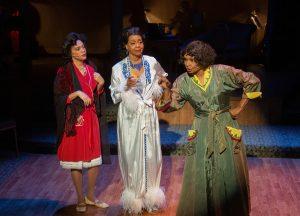No, Blues in the Night is not the new theme song that the post-Election Day Democrats are singing. Rather, it is a show starring that distinctly African American art form, the Blues, directed by Ebony Repertory Theatre’s Wren T. Brown and conceived by Sheldon Epps. In the Tony and Olivier award nominated Night four singers croon and belt out 26 songs, many of them created by luminaries of the genre such as Duke Ellington (“I’m Just A Lucky So-And-So”), Bessie Smith (“Blues Blues”), Benny Goodman (“Stompin at the Savoy”) and the eponymous “Blues in the Night” by Harold Arlen and Johnny Mercer. Happily, none of the music was lip synched and all the numbers were performed by a live quintet.
Three of Night’s warblers are female, and I believe these ladies who sing the Blues are intended to represent women at different stages in their lives. Jenna Gillespie Byrd portrays the character identified in the program as “The Girl with a Date,” who I guess personifies youth. As “The Woman of the World,” Karole Foreman (who previously played Billie Holiday in Lady Day at Emerson’s Bar and Grill, so her appearance here could be called “Day for Night”) personifies middle age. Broadway veteran and two-time Tony nominee Vivan Reed portrays “The Lady from the Road,” an aging onetime performer, perhaps on Vaudeville or chitlin circuit stages. At the opening night performance Chester Gregory, who also has a string of Great White Way credits, portrayed Night’s sole male character, “Man in the Saloon.”
The trio of women are adorned in period dress (and sometimes undress, in fashions by costume designer Kim DeShazo) and tread the boards of a set identified in the program as a Chicago Hotel in 1948. The semi-thrust stage (scenic designer Edward E. Haynes Jr.) is subdivided into three sections, each supposed to be their own separate hotel rooms, while the musicians are discretely situated behind the stage, silhouetted by a curtain. In the ladies’ boudoirs they sing solo or sometimes they come together and hold forth jointly (the Man in the Saloon joins them from time to time).
The story, such as there is one, largely consists of the chanteuses’ recurring theme – disappointment in romance and how the men in their lives have generally let them down. Call it the “Man-demic.” Alas, the Man in the Saloon fares no better and is likewise unlucky in love, and their disillusion and lamentations are expressed through various Blues songs.
Sometimes their reason for singing the proverbial and literal Blues shifts, and occasionally the source of their dissatisfaction becomes what Reed’s character calls “white folks.” But the sense this Caucasian reviewer perceived is that the racism the singers complain about is not so much the harsh oppression of, say, police brutality, but more of a feeling of being marginalized in a dominant majority culture they are permitted to merely subsist in, usually on the sidelines, and usually on “whitey’s” terms. (My word, and not the show’s, and I mean it in the sense of white supremacists.)
The repetitive lovelorn nature of the numbers becomes wearisome. As The Lady from the Road, Reed’s schtick is that she is an aging “broad” (again, my word, to describe how her persona is presented) and entertainer who has seen better days, but is, gosh darn it!, determined to prove that she’s still got “it”, and remains able to sing, dance (choreo by Keith Young) and have sex. This repeated routine also quickly wears out its welcome.
I enjoyed a few of the songs, especially the radiant Jenna Gillespie Byrd’s lilting, exuberant, hopeful rendition of “Taking a Chance on Love,” by Vernon Duke, John La Touche and Ted Fetter, which is in my estimation the best performance of the Night. I was also moved by an expert iteration of “Nobody Knows You When You’re Down and Out,” by Jimmy Cox. Plus there is a lovely if brief poignant warbling of the haunting “Am I Blue?” by Grand Clarke and Harry Akst. (Given the downbeat tone of the show I was shocked that “Nobody knows the trouble I've seen” wasn’t included – but perhaps that’s because it’s a Black Spiritual number dating back to antebellum days, not a Blues song per se.)
Musical director William Foster McDaniel, who is Night’s pianist and conductor, tickles the ivories admirably. As the music is the real star of this show, it’s a pity that Del Atkins on bass, Clayton Cameron on drums, Scott Mayo on woodwinds and Fernando Pullum, are kept offstage instead of being where they, along with McDaniel, should rightfully be: In centerstage. After all, this seems to me to be more of a music show than a musical per se (I don’t believe there’s a single solitary original song in it). Blues in the Night will probably be best appreciated by diehard Blues fans.
Blues in the Night is being performed Thursday, 8:00 p.m., Nov. 4; Friday, 8:00 p.m., Nov. 5; Saturday, 8:00 p.m., Nov. 6; and closes Sunday, 2:00 p.m., Nov. 7 at INTERNATIONAL CITY THEATRE, Long Beach Performing Arts Center, 330 East Seaside Way, Long Beach, CA 90802. Info: (562)436-4610 or Home • International City Theatre (ictlongbeach.org).




